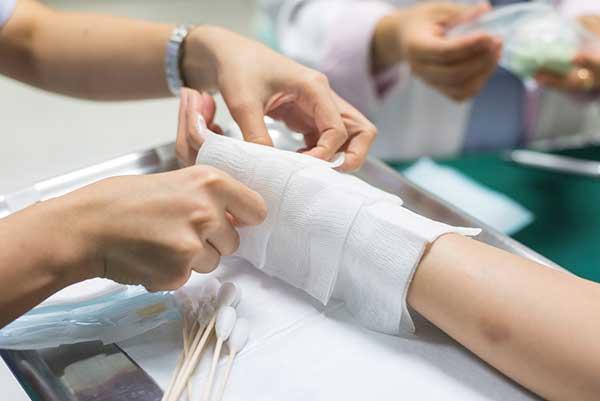Burns: When to Visit the ER

Burn Symptoms and Emergency Room (ER) Treatment
Burns are a fairly common skin injury that can range from very minor to severe. Burns can be caused by fire, sun exposure, appliances, electricity or contact with certain types of chemicals.
The severity of a burn injury usually depends on the length or degree of exposure to the harmful substance. Small or minor burns are common and can sometimes be treated without the help of a medical doctor or without visiting the emergency room.
However, severe burns have the potential to become a life-threatening condition and should be treated immediately by emergency medical personnel.
SkiptheWaitBook an Appointment Today
Common Causes of Burns
Natural or environmental conditions –
Fire – One of the most common causes of burns is direct or indirect exposure to open flames. Whether the exposure is caused by a campfire or a stove burner, even brief exposure to open flames can result in serious burn injuries.
Heat – Exposure to high levels of heat can result in burns. Open flames do not have to be present for it to occur. Prolonged exposure to high heat levels can result in dehydration and burned or blistered skin.
Sun Exposure – Long-term exposure to direct sunlight is responsible for one of the most common types of burns: sunburns. People with light-colored skin can become sunburned after only a few minutes in direct sunlight. Although sunburns are usually minor, certain medications and health conditions can make direct sunlight exposure potentially severe.
Hot Water – Burns from hot water, or scalding injuries, are the leading cause of burns in small children. A pot of water boiling on the stove can be spilled, resulting in very severe injuries that require emergency medical treatment or a visit to the emergency room. In serious cases, scalding injuries can be fatal.
Equipment, appliance, or work-related causes –
Electricity – When electrical equipment fails or is used improperly, serious burns can be the result. Frayed wires, unsafe work practices or failure to wear safety gear can all lead to electrical burns.
Chemical – Direct contact with hazardous chemicals can lead to some of the most serious types of burns. Although these kinds of burns are more common in certain professions, some household products have the potential to cause severe chemical burns.
Radiation – Radiation burns are always serious. Working with certain kinds of equipment can lead to radiation burns if safety practices are neglected. Radiation burns almost always require emergency medical treatment.
Other Causes of Burn
Friction – From simple rug burns to motor vehicle accidents, friction burns can be extremely painful. Friction generates high levels of heat, leading to blistered skin, painful rashes and damaged muscle tissue. Friction burns can be especially dangerous because they sometimes occur in the context of other injuries such as broken bones from a vehicle crash.
Mild vs. Severe Burn – How to Know if Your Burn is Mild or Severe
If you have suffered a minor burn, it may be possible to treat it at home with cool water, cold compresses, and over-the-counter pain relievers. However, if you have severe burn or a burn injury that persists without healing or remains very painful, it is best to visit an emergency room near you.
Symptoms of a bad severe burn can include:
- Severe, debilitating pain
- Burns covering large portions of your body
- Burns caused by radiation or chemical exposure
- Burns that are accompanied by other injuries
- Difficulty breathing
- Dizziness or weakness
- Nausea or vomiting
When to Visit Emergency Room (ER) for Burn Treatment
Head to the ER immediately if your burn –
- Is blistering and only painful with deep pressure. This could be a third-degree burn and may involve more than just your skin.
- Affects sensitive areas like your face, hands, feet or genitals. As scar tissues in these sensitive areas heal they could interfere with normal functions associated with these areas of the body
- Is painful and blisters. This could be a second degree burn and only a medical doctor can determine if some antibiotics are needed to treat an infection If you have suffered a burn injury, please visit one of our emergency room locations immediately. We are here to help 24/7.
For fast, reliable treatment, you can visit one of our emergency room locations. We are open 24/7.
- Alcohol Withdrawal Detox
- Allergic Reaction
- Asthma
- Abdominal Pain
- Causes of Abdominal Pain
- Bronchitis
- Back Pain
- Burns
- Chest Pain
- Cuts & Lacerations
- Dental Emergency
- Dehydration
- Fractures
- Head Injuries
- Heatstroke
- HIV
- Insect Bites and Stings
- Influenza
- Multi-slice CT Scan
- Seizure – Causes, When to Go to ER
- Tetanus Shots
- Ultrasound Imaging Services
- Migraine
- Pneumonia
- Skin Rash
- Vomiting and Diarrhea




